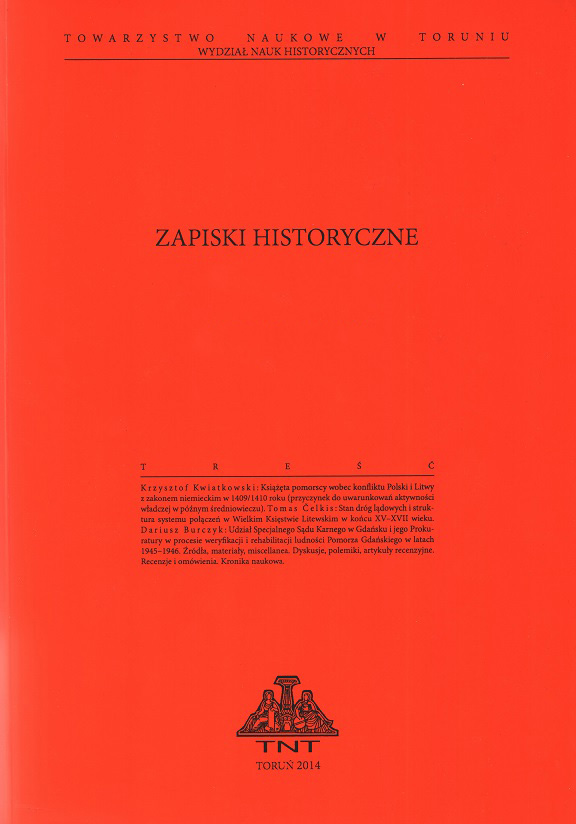The Picture of the City of Gdańsk in the Historiography From Beyond Gdańsk in the Late Middle Ages and the Beginning of the Early Modern Period
The Picture of the City of Gdańsk in the Historiography From Beyond Gdańsk in the Late Middle Ages and the Beginning of the Early Modern Period
Author(s): Julia MożdżeńSubject(s): Cultural history, Historical Geography, Diplomatic history, Social history, 15th Century, 16th Century
Published by: Towarzystwo Naukowe w Toruniu
Keywords: city;the Middle Ages;the early modern period;chronicle;historiography;travel accounts
Summary/Abstract: This article places into a broader scope of the research over the image of Gdańsk and its inhabitants in chronicles that are carried out by the authoress. It deals with the analysis of the historiographical sources originating from beyond Gdańsk. The majority of chronicles’ excerpts dedicated to Gdańsk deals with its political and trade activity. The authoress is particularly interested in the criteria, put forward by the chroniclers from 15th to 16th c., which decided on Gdańsk’s urban character, or indicated its value as a city and made it worth a visit. It was a period of intense development of this centre. The purpose of the analyses is to, i.a., check whether the contemporary chroniclers observed these changes and how they evaluated them. The issue has not yet been addressed in the literature of the subject. The analyses, referring to Hans Werner-Goetz’s methodology concerning the representations in chronicles (so-called Vorstellungsgeschichte), were carried out on various chronicles, relations and records, i.a. travel records (Gilbert de Lannoy and Mikołaj Wimann), Polish chronicles (Annales by Jan Długosz, chronicles by Bernard Wapowski, Joachim Bielski, Polonia by Marcin Kromer), foreign chronicles Germania by Eneas Silvius Piccolomini, Wandalia by Albert Krantz), or universal chronicles (Cosmographia by Sebastian Münster). The analysis shows that in the first half of the 15th century the contemporaneous authors did not stand out of other towns in the region (Jan Długosz, Gilbert de Lannoy, Eneas Silvius Piccolomini). Their assessment was made while they pondered on the city’s fortifications, geographical location and building material. It was not until the Thirteen Years War (1454–1466) and subsequent expansion of the city that the chronicles of the 16th c. noticed the ongoing change (especially Albrecht Krantz and Sebastian Münster). They described the “civilizational leap” that took place in Gdańsk in short time, namely during the life of one man. In their opinion, the changes were particularly noticeable in the fast pace of replacing wooden buildings with brick ones. The image of Gdańsk in the foreign chronicles does not contain elements of the descriptions of the city characteristic of Gdańsk records, which the authoress analyzed elsewhere – there are no references to specific buildings, streets and squares, that is, the living space of the city’s inhabitants.
Journal: Zapiski Historyczne
- Issue Year: 83/2018
- Issue No: 4
- Page Range: 25-48
- Page Count: 24
- Language: English

